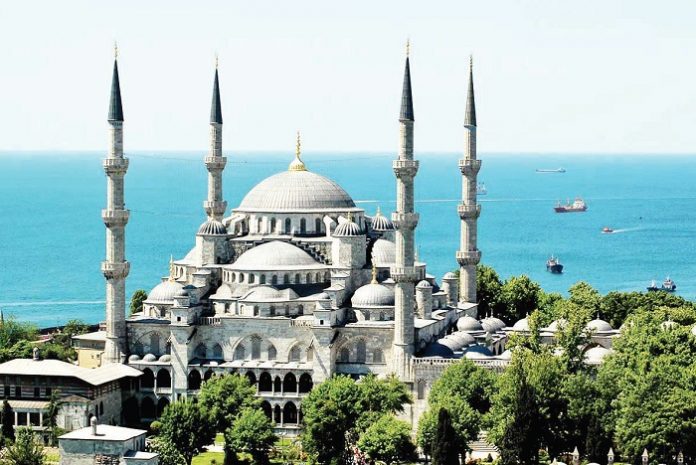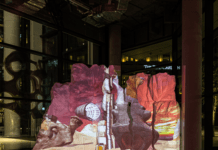The city where Europe meets Asia has long played host to history on an epic scale. From Byzantine churches to Ottoman palaces, its well-preserved heritage is still very present on a visit to Turkey’s largest city. Religious buildings: Commissioned by the Byzantine emperor Justinian in 532 AD, the Aya Sofya was Christendom’s crowning jewel for a millennium. It became a mosque under the Ottomans and is now a museum. A vast, seemingly unsupported dome crowns golden mosaics and stained-glass windows that bathe the space in ethereal half-light. In the 1600s, Sultan Ahmed I set out to build a mosque to surpass Aya Sofya.
He came close: the curvaceous exterior of the Blue Mosque (formally, Sultanahmet Mosque) and its six minarets (a record at the time) dominate the Old City skyline. The interior features stained glass, marble latticework and tens of thousands of fine blue tiles; after which the mosque is named (Hippodrome; closed to visitors at prayer times; donation requested). The 16th-century Süleymaniye Mosque, set atop one of the city’s seven hills, was commissioned by the richest and most powerful of sultans, Süleyman the Manificent, and certainly lives up to its patron’s name. Designed by Mimar Sinan, the most renowned of all imperial architects, its spacious, light-filled interior is patterned with Iznik tiles and stained glass windows.
Old City monuments: The Basilica Cistern, a magnificent underground reservoir, has 336 columns – each 9 meters high – arranged in 12 rows beneath a vast vaulted ceiling. The effect is striking: a symmetrical, softly lit forest of pillars reflected in a mirror of water below. Visitors walk through on raised wooden boards while schools of ghostly carp flit through the waters below.
Home to the ruling sultans of the Ottoman Empire from the 1460s to the 1850s, the Topkapi Palace encompasses richly decorated chambers, tile-lined pleasure pavilions overlooking the Bosphorus and the private world of the harem. Extravagant relics of the dynasty’s intrigue and excess abound, among them lavish costumes, an 86-carat diamond and a jewel-encrusted dagger. Founded more than 500 years ago by Mehmet II, Istanbul’s first Ottoman ruler, the Grand Bazaar has grown from humble origins into one of the most famous souqs in the world.
A covered city within a city, its miles of alleyways are lined with over 4,000 shops stacked with everything from antiques, jewellery and carpets to Turkish delight. Its Old Book Bazaar dates back to Byzantine times.
Leisure buildings: The Çemberlita’ Hamami is one of the city’s most beautiful Turkish baths. Designed by the architect Sinan, it has separate baths for men and women, with bathing basins, private cubicles and an ornate, domed chamber at its centre. Treatments include exfoliating scrubs and oil massages. The elegant Zihni Bar inhabits a century-old apartment in the Ni’anta’ı district, designed by the architect Vedat Tek, famed for his ornate Ottoman-style buildings.
The whole place is a time-warp of wood panelling, tiled alcoves, ornate ceilings and stained glass, and makes for an evocative place for a cocktail or glass of Turkish wine. Tucked away in the district of Fatih next to the exquisite Chora Church, the elegant courtyard restaurant Asitane offers a taste of Ottoman imperial cuisine. Its team have spent decades hunting down and testing historic recipes. From cinnamon-dusted chicken to vine leaves stuffed with sour cherries, the fruits of their labours are truly fit for a sultan’s table.
Transport: The most enjoyable way to get around is via one of numerous ferry routes. Between them, the city’s handful of metro, train, tram and light rail lines serve a sizeable area. The fare across public transport is at a minimum, and the Istanbulkart smart card gives discounts. Taxis are another cheap way to get around.
Stay: The Hotel Sari Konak is full of historic touches such as antiques, etchings and embroideries. Relax by the courtyard fountain, or take in city views from the rooftop terrace Next to historic Galata Tower, Anemon Galata features elegant rooms with painted ceilings and an opulent foyer. The glass-walled rooftop restaurant offers splendid views.The 120-year-old and recently renovated Pera Palace Hotel has long been the choice of famous travellers, most notably Agatha Christie. The hotel retains a sense of luxury in its grand public spaces.

















